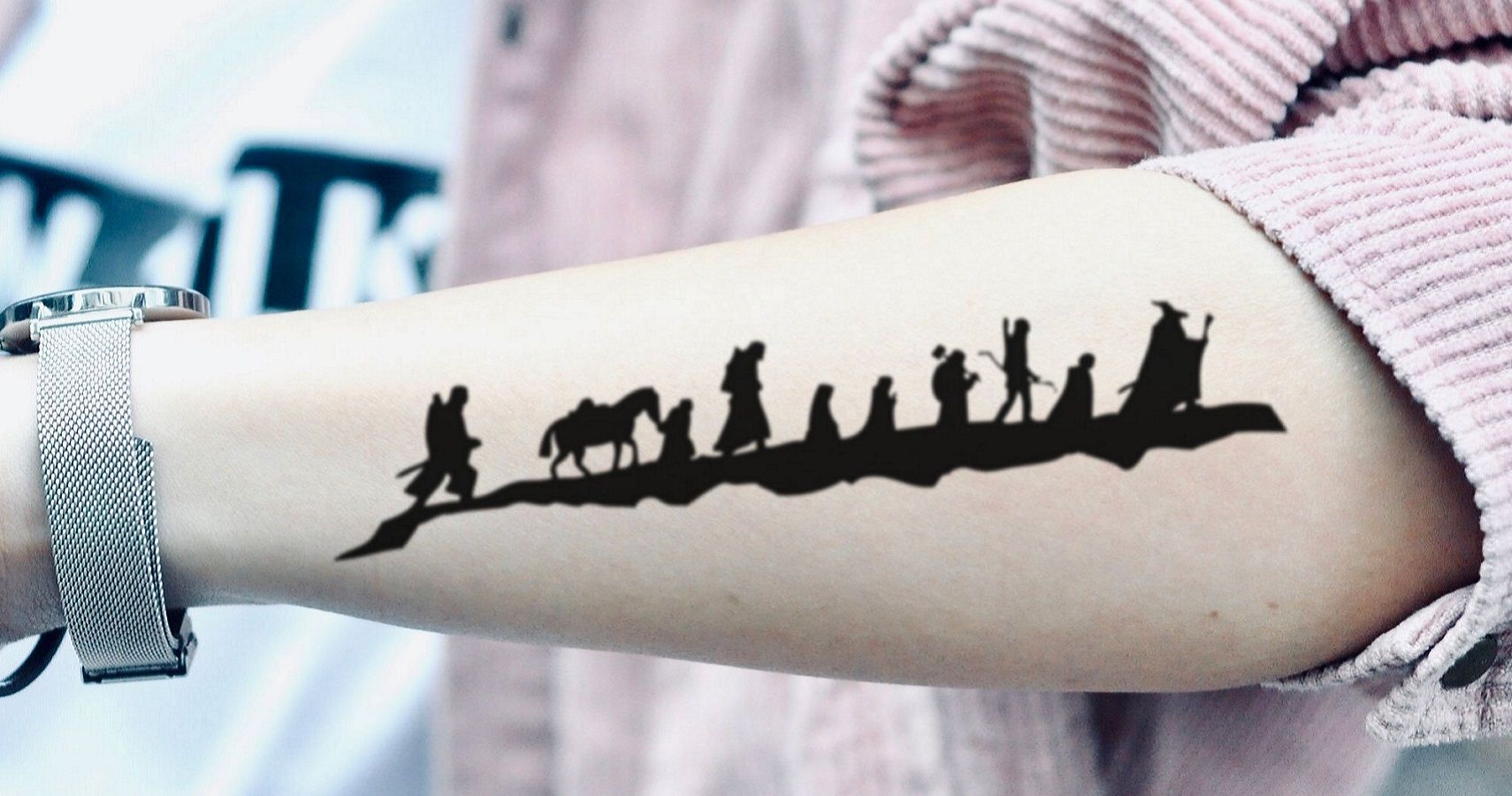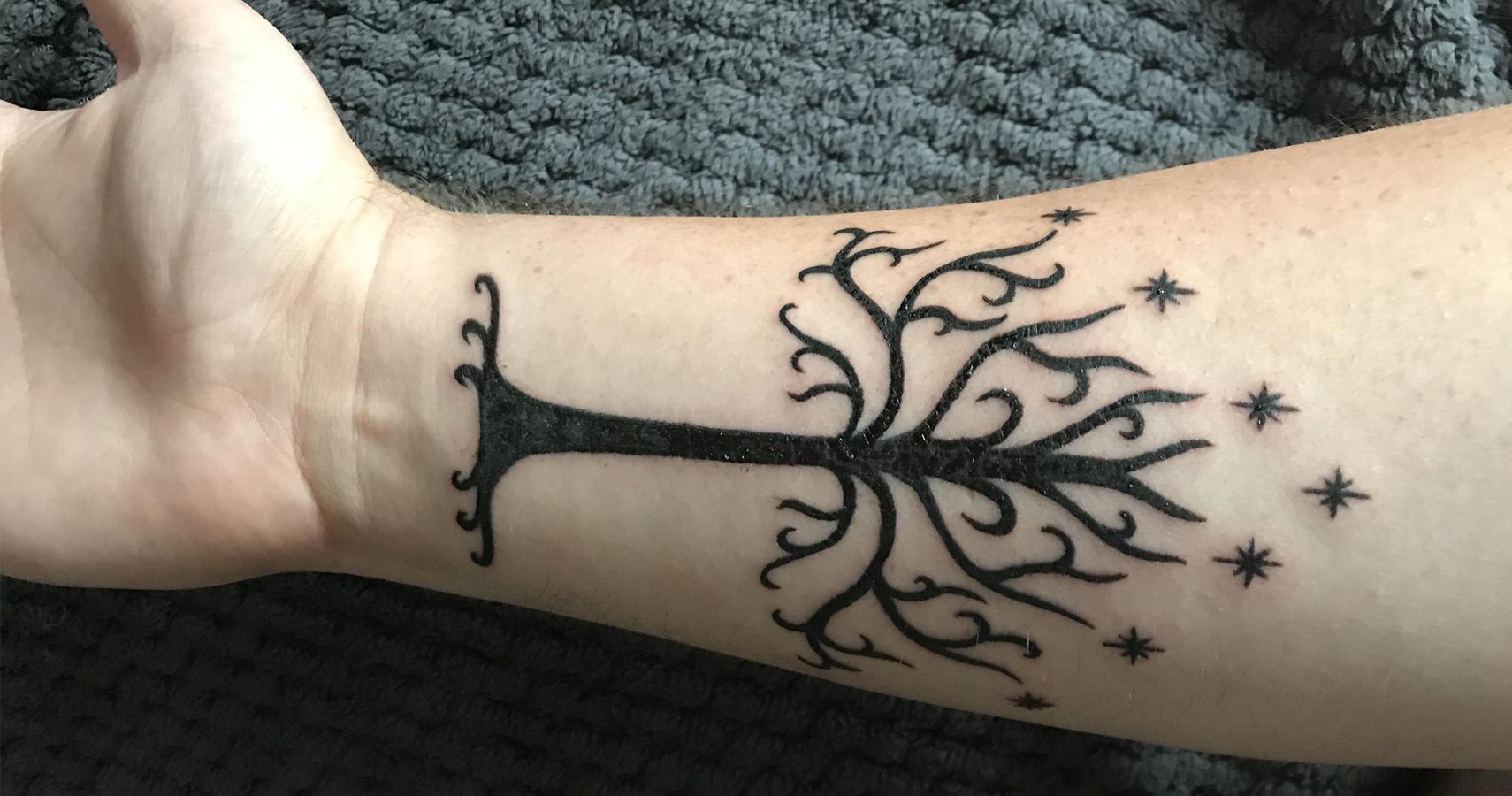While not the first high fantasy story, J.R.R. Tolkien's The Lord of the Rings set the precedent for most, if not all, high fantasy stories that came after it. The entire trilogy went on to be adapted twice: once as animated films in 1978 and 1980; and the live-action Peter Jackson films from the early 2000s. A prequel series produced by Amazon Prime is also in the works.
Along with the books and the films, there are other books written by Tolkien about Middle Earth such as The Hobbit and The Silmarillion. The massive amount of canon has given fans plenty of references and information to pay homage to in their art, cosplay, and tattoos.
Tattoos especially are good for references to popular culture such as The Lord of the Rings because it provides fans with the opportunities to be as minimalistic or as detailed in their designs as they want to be. Regardless of the amount of detail, and because of the amount of information that Tolkien and those who have adapted and are adapting his works have provided fans, there is a chance that some tattoos may only be recognizable by fans. Here are 10 Lord of the Rings tattoos that only these true fans will understand.
Tree of Gondor
The Tree of Gondor is the symbol of the south kingdom of Middle Earth named Gondor. The tree stood in the Court of the Fountain, part of the topmost level of Minas Tirith, until the fourth tree died having produced no sapling. It was at first left standing but was eventually moved to the Tombs of the Kings and given royal honors.
In The Return of the King, Aragorn, newly crowned king, and Gandalf discovered a new sapling of the tree but this time high up on the slopes of Mindolluin, an eastern peak of the White Mountains.
The Tree of Gondor is also part of the Livery of Elendil, which features the tree, seven stars, and the crown of Gondor.
Door Of Hobbit-Hole Opening To Traveling Fellowship
The door of a hobbit-hole, or hobbit dwelling, is open to the Fellowship, shown traveling through the mountains to Mordor. The Fellowship consists of Frodo Baggins, Samwise "Sam" Gamgee, Peregrin "Pippin" Took, Merry Brandybuck, Aragorn, Gandalf, Legolas, Gimli, and Boromir. The Fellowship was formed after the Council of Elrond and was tasked with taking the One Ring to Mordor and destroying it.
Related: 15 Secrets You Didn't Know Behind The Making Of Lord Of The Rings
The door of the tattoo is an unspecified door but is likely the door to Bag End, the residence of Bilbo and Frodo Baggins, and the most well-known hobbit-hole.
Sauron And The One Ring Inscription
Even those unfamiliar with The Lord of the Rings may have heard of the Eye of Sauron. Lesser known is Sauron's physical, humanoid form, portrayed as a knight in black armor. He is the primary antagonist of The Lord of the Rings. He created the One Ring in order to gain control of the free peoples of Middle Earth and seeks to get it back during the time in which the trilogy took place.
The words around Sauron are the inscription on the One Ring, written in Black Speech: "One ring to rule them all, one ring to find them, one ring to bring them all and in the darkness bind them."
Sting With A Quote From Sam Gamgee
"Don't go where I can't follow," is one of the most well-known lines from The Lord of the Rings. Sam says it to Frodo after an altercation with the spider named Shelob and Gollum. Sam warded off Shelob and Gollum on his own and unwrapped Frodo from the web in which he was trapped. Thinking Frodo was dead, Sam started talking to Frodo, willing him to live. The famous quote was part of what he said.
It is possible that even non-fans may recognize the quote, but they likely will not recognize the sword with which it is paired. The sword is named Sting, and originally belonged to Bilbo Baggins. Bilbo gave it to Frodo, who in turn gave it to Sam.
Saruman's Hand, Palantír, And The Eye Of Sauron
Saruman is a wizard and an antagonist in The Lord of the Rings. He used palantír, described as a crystal ball-type magical artifact. His use caused him to misinterpret power he found in Mordor through the artifact, which led to his corruption shown in the trilogy.
Related: Lord Of The Rings: The 10 Most Terrifying Scenes, Ranked
Sauron was another user of palantír. He was able to cause a weaker user, like Saruman, to have false impressions of what he was viewing. Other users of palantír encountered Sauron during their use of it, such as Pippin and Aragorn, the latter of whom was able to put a stop to Sauron's manipulation of its power.
Gandalf's Signature
Gandalf is a wizard who is part of the Fellowship. He had previously helped Bilbo while on his first journey outside The Shire. Gandalf is incredibly knowledgable of other languages and cultures, sometimes more so than he lets on. The tattoo above is what Gandalf uses as a personal sign or seal, acting as his signature.
It is the "G" in the Cirth alphabet, which was invented by Tolkien. In his works, the Grey Elves use it as the alphabet for their language, Sindarin. The alphabet is based on real runic alphabets.
Doors Of Durin
The Doors of Durin are also known as the west-gate or the west-door of Moria. The Fellowship, who intended to cross through Moria after being pursued by Orcs, had to figure out how to open the doors, which was seemingly impossible. Part of the inscription, written in Sindarin, says "speak friend and enter," which ended up being the clue that the Fellowship needed to open the door.
The inscriptions and the artwork are inlaid in the door with ithildin, which is derived from mithril, a precious metal. Ithildin is only visible under the light of the moon and the stars.
Narsil
Narsil was wielded by Elendil. Elendil was killed by Sauron in the Battle of Dagorlad. Isildur then fought in Elendil's stead with Narsil, but Sauron shattered the sword. Isildur was able to use what was left of the sword to strike Sauron and cut the One Ring from his hand.
Related: Lord Of The Rings: 24 Creatures Ranked From Weakest To Most Powerful
What was left of the sword was then kept in Rivendell until The Return of the King when Arwen convinced her father Elrond to reforge the sword, which is also when it was renamed Andúril. It was later presented to Aragorn by Elrond himself in Dunharrow.
The tattoo above depicts Narsil after it was shattered by Sauron.
The Gates Of Argonath
In the books, the Gates of Argonath, also known as just Argonath, were to giant statues in the likeness of Isildur and Anárion. The Gates stood at both sides of the river of Anduin and marked the northern border of Gondor. The statues themselves were made to commemorate Rómendacil II's victory over the Easterlings. The Fellowship passed through these gates during the events of The Fellowship of the Ring.
In the Peter Jackson films, the statues depicted Isildur and Elendil, rather than Anárion, the latter of whom is not addressed at all in the films.
Evenstar
The Evenstar is exclusive to the Peter Jackson film adaptations. The Evenstar is a silver necklace with a white stone, which Arwen gives to Aragorn while they are both at Rivendell.
The Evenstar in the film replaces the Elfstone in the books, which is a silver brooch with a gem with the light of the sunset on the brooch. Like the Evenstar, the Elfstone eventually falls into Arwen's possession. However, Galadriel also obtained it a number of times, and it was Galadriel who set it aside, intending to give it to Aragorn.
Next: Star Wars Vs. Lord Of The Rings: 10 Best Movies, According To IMDb


